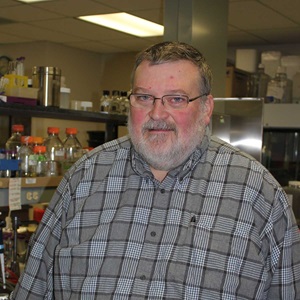Douglas G. Cole
Douglas G. Cole
Professor and Associate Chair
Life Sciences South 162
208-885-4071
Dept. of Biological Sciences
University of Idaho
875 Perimeter MS 3051
Moscow, Idaho 83844-3051
Research: Cellular & Molecular Biology, Biochemistry
- Ph.D. Washington State University
- Intraflagellar Transport
- IFT may transport axonemal precursors
- IFT polypeptides
- IFT raft architecture
- Kinesin-II
- The anterograde IFT motor
- Behal RH, Miller MS, Qin H, Lucker BF, Jones A, and Cole DG. (2012) Subunit Interactions and Organization of the Chlamydomonas reinhardtii Intraflagellar Transport Complex A Proteins. J. Biol Chem. , in press
- Silva DA, Huang X, Behal RH, Cole DG, and Qin H. (2011) The RABL5 homolog IFT22 regulates the cellular pool size and the amount of IFT particles partitioned to the flagellar compartment in Chlamydomonas reinhardtii. Cytoskeleton 69:33-48.
- Diener DR, Yang P, Geimer S, Cole DG, Sale WS, and Rosenbaum JL. (2011) Sequential assembly of flagellar radial spokes. Cytoskeleton 68:389-400.
- Betleja E, and Cole DG. (2010) Ciliary trafficking: CEP290 guards a gated community. Curr. Biol. 20:R928-931. PMID: 21056833
- Fan FZ, Behal RH, Geimer S, Wang Z, Williamson SM, Zhang H, Cole DG, and Qin H. (2010) Chlamydomonas IFT70/CrDYF-1 is a core component of IFT particle complex B and is required for flagellar assembly. Mol. Biol. Cell 21:2696-2706. PMCID: PMC2912355
- Lucker BF, Miller MS, Dziedzic SA, Blackmarr PT, and Cole DG. (2010) Direct interactions of intraflagellar transport complex B proteins IFT88, IFT52 and IFT46. J. Biol. Chem. 285:21508-21518. PMCID: PMC2898376
- Cole DG, Snell WJ. (2009) Snapshot: Intraflagellar transport. Cell 15:784-784.e1. PMID: 19450523
- Behal, RH, Betleja, E, and Cole, DG. (2009) Purification of IFT Particle Proteins and Preparation of Recombinant Proteins for Structural and Functional Analysis. In “Methods in Cell Biology, Volume 92, Cilia: Motors and Regulation, Chapter 10, pg 179-196.” (S. King and G. Pazour, Ed.) Academic Press, San Diego. PMID: 20409818
- Cole, DG (2009). Intraflagellar Transport. In “The Chlamydomonas Sourcebook: Cell Motility and Behavior, 2nd Edition, Volume 3, Chapter 4, pg 71-112.” (G. Witman and E. Harris, Ed.) Academic Press, San Diego. PMID: 16213810
- Redding KE, Cole DG. (2008) Chlamydomonas: a sexually active, light-harvesting, carbon-reducing, hydrogen-belching 'planimal'. EMBO Rep. 9:1182-1187.
- Ahmed NT, Gao C, Lucker BF, Cole DG, Mitchell DR. (2008) ODA16 aids axonemal outer row dynein assembly through an interaction with the intraflagellar transport machinery. J. Cell Biol. 183:313-322. PMCID: PMC2568026
- Flom, G, Behal RH, Rosen L, Cole DG, Johnson JL. (2007) Definition of the minimal fragments of Sti1 required for dimerization, interaction with Hsp70 and Hsp90 and in vivo functions. Biochem. J. 404:159-167. PMCID: PMC1868838
- Miller MS, Esparza JM, Lippa AM, Lux III FG, Cole DG, Dutcher SK (2005) Mutant kinesin-2 motor subunits increase chromosome loss. Mol. Biol. Cell 16:3810-3820. PMCID: PMC1182318
- Lucker BF, Behal RH, Qin H, Siron LC, Taggart WD, Rosenbaum JL, Cole DG. (2005) Characterization of the intraflagellar transport complex B core: Direct interaction of the IFT81 and IFT74/72 subunits. J. Biol. Chem. 280:27688-27696. PMID: 15955805
- Pedersen LB, Miller MS, Geimer S, Leitch JM, Rosenbaum JL, Cole DG. (2005) Chlamydomonas IFT172 is encoded by FLA11, interacts with CrEB1, and regulates IFT at the flagellar tip. Curr. Biol. 15:262-266. PMID: 15694311
- Structure-function analysis of intraflagellar transport machinery
Mediated by protein complexes with >20 components, intraflagellar transport (IFT) is responsible for moving materials in and out of eukaryotic cilia and flagella. A major goal of the lab is focused on understanding the molecular basis of IFT function by studying both the structure and function of the protein components. - Molecular basis for gliding motility in Chlamydomonas reinhardtii
In addition to swimming, the biflagellated green algae, Chlamydomonas, can use its flagella to physically attach and then glide across a surface. The protein required for contact with the environmental surface, FMG-1B, has been identified but little is known about how the gliding forces are generated. To better understand this motility, we are identifying and characterizing proteins that are associated with the gliding machinery. - Algal production of oil for nutritional and biofuel applications
Many animals, including man, have been shown to require essential polyunsaturated fatty acids (PUFA) in their diet. The origin of much of these PUFA are microscopic photosynthetic organisms such as diatoms and green algae. With this in mind, our lab has undertaken a regional sampling of photosynthetic microorganisms. Important in this line of bioprospecting is a quantitative lipid analysis to identify the distribution of fatty acids.
- Grant application reviewer for the National Science Foundation, the National Institutes of Health, and assorted European agencies.
- Editorial Board, Cilia
- Reviewer (selected titles), Cell, Current Biology, Cytoskeleton, EMBO Journal, Genetics, Journal of Biological Chemistry, Journal of Cell Biology, Journal of Phycology, Molecular Biology of the Cell, Nature, Proceedings National Academy of Sciences, PLoS Genetics and Zoology.
- 2010 Outstanding Advisor Award, College of Agricultural & Life Sciences, University of Idaho.
- 2006 Excellence in Teaching Award, WWAMI Medical Education Program, University of Idaho.







